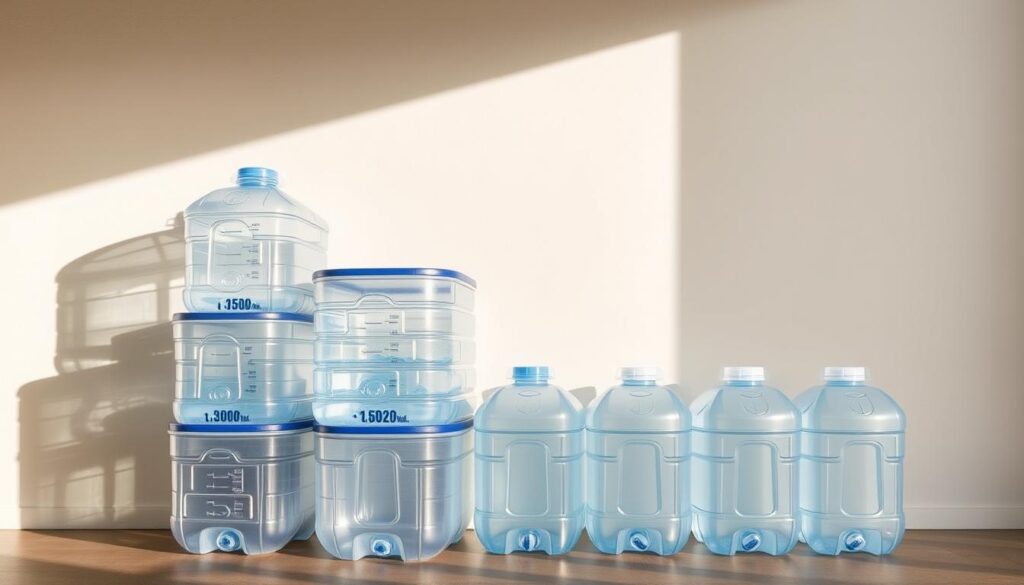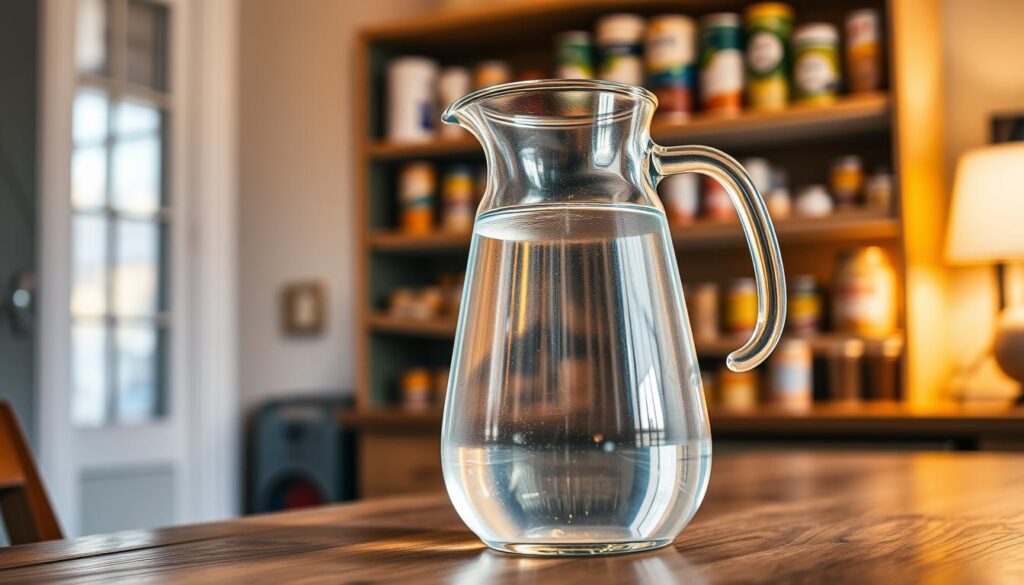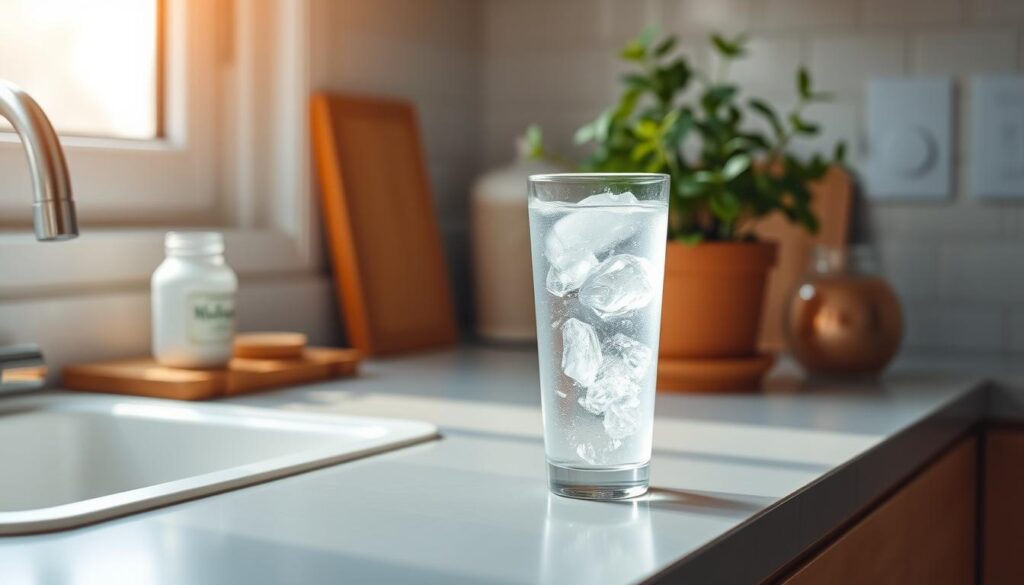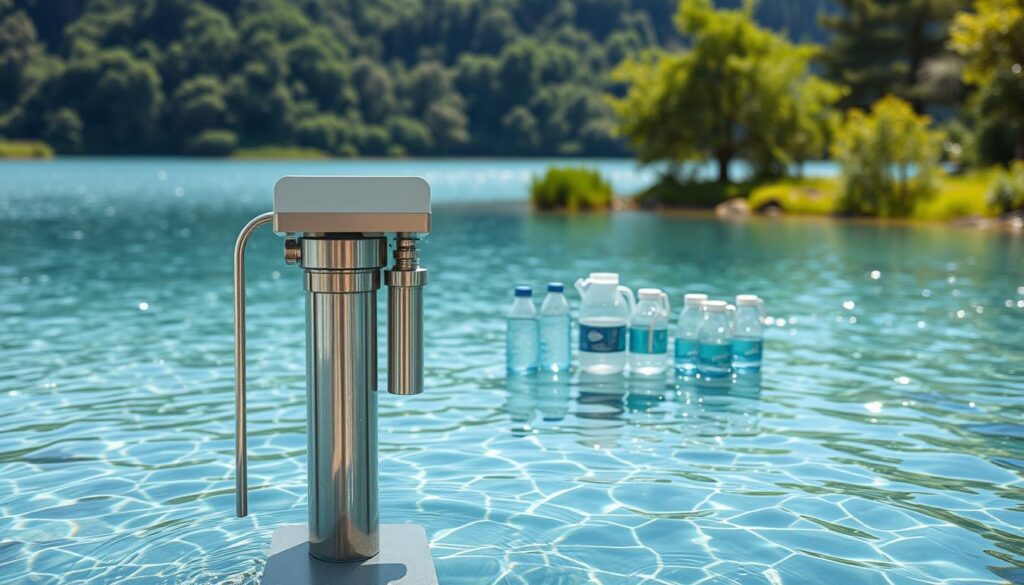Having a reliable supply of clean drinking water is key during unexpected crises. Natural disasters, power outages, or emergencies can cut off our access to safe drinking water.
Creating a detailed guide to emergency preparedness is essential for keeping myself and my loved ones safe. This guide will cover the critical steps to prepare your emergency water supply. We’ll go from figuring out your needs to storing and purifying water.
Key Takeaways
- Understand the importance of having a reliable water supply during crises.
- Learn how to determine your water needs for emergency situations.
- Discover the best methods for storing and purifying water.
- Prepare a disaster supplies kit that includes water and other essentials.
- Stay safe and hydrated during emergencies with a complete emergency preparedness plan.
Understanding the Importance of Emergency Water Supply
In times of crisis, having clean drinking water is key to survival. Water is vital for our health, and its value grows in emergencies.
The Role of Water in Survival Situations
Water is essential in survival situations. It keeps us hydrated, clean, and boosts our spirits. When disasters strike, clean water might be hard to find. That’s why having a emergency water supply is critical.
It’s important to have enough water for drinking, cooking, and staying clean. Experts suggest storing at least three days’ worth. But, this can change based on your needs and the situation.
Potential Emergencies Requiring Preparedness
Many emergencies can cut off our access to clean water. This includes natural disasters like hurricanes, earthquakes, and floods. Being ready with a good water supply and the right water storage containers helps a lot.
- Natural disasters
- Power outages
- Water main breaks
- Other emergencies that may disrupt water services
Psychological Benefits of Preparedness
Having a ready emergency water supply does more than keep you alive. It also brings peace of mind. Feeling prepared can lower your stress and anxiety, helping you stay focused.
Being prepared also gives you a sense of control and confidence. These feelings are priceless during tough times.
How Much Water Should I Store?
Many people wonder how much water they should store for emergencies. The amount needed depends on several things. These include the number of people in your home, your climate, and your personal needs.

Recommendations by Experts
Experts say you should store at least one gallon of water per person per day. This is for drinking, cooking, and keeping clean. It’s key for emergency water storage and makes sure you have enough drinking water storage in a crisis.
For a family of four, you’ll need at least 16 gallons of water per day. But, this is just a starting point. You might need more water based on your situation.
Factors Influencing Water Quantity Needs
Several things can affect how much water you need. For example, people living in hot places need more water because they sweat more. Also, those with health issues or who are pregnant might need extra water.
- Climate: Hotter climates require more water for hydration.
- Age and Health: Older adults, pregnant women, and people with certain medical conditions may need more water.
- Activity Level: Individuals who are physically active may need more water.
Calculating Water for Pets and Livestock
Don’t forget to think about your pets and livestock’s water needs too. The amount needed varies based on the animal’s type and size.
Dogs need about one ounce of water per pound of body weight each day. So, a 50-pound dog needs about 50 ounces (or about 1.5 liters) of water daily. Livestock, like cattle, need a lot more water, often between 10-20 gallons per day.
By considering these factors and calculating your total water needs, you can make sure you have enough water stored. This will help both your family and your animals in emergencies.
Best Storage Methods for Emergency Water
Storing water properly is key to being ready for emergencies. The quality of your water can greatly affect your health and safety during a crisis.
Selecting Appropriate Containers
It’s important to pick the right containers for storing emergency water. Food-grade water storage containers are best because they are safe for drinking water. They are made to last and won’t rust easily.
- Choose containers that are FDA-approved to ensure they are safe.
- Think about the size and how easy they are to carry based on your needs.
- Make sure the containers are clean and sanitized before you use them.
Tips for Proper Water Storage
Keeping your emergency water supply clean is essential. Here are some tips to help:
- Store water containers in a cool, dark spot, away from sunlight and harmful substances.
- Keep containers off the floor to avoid contamination and damage.
- Check containers regularly for any damage or leaks.
Temperature and Safety Considerations
Temperature and safety are very important when storing emergency water. Water stored at the right temperature is less likely to grow bacteria.
Avoid storing water containers near heating vents, ovens, or other heat sources. The best storage temperature is between 50°F and 70°F (10°C and 21°C). Also, watch out for chemical contamination from nearby substances.
Water Purification Techniques to Know
Learning about water purification methods is key for survival in emergencies. Clean drinking water is essential. Knowing how to purify water is a vital skill for being ready for emergencies.
Common Methods for Purification
There are many ways to purify water, like boiling, chlorination, and distillation. Mastering emergency filtration is also important. It ensures you have a reliable source of clean water.
Boiling water is simple and effective. It kills bacteria, viruses, and other pathogens. Just boil the water for 1-3 minutes.
Using Water Filters and Chemical Treatments
Water filters and chemical treatments are also good for purifying water. Filters remove particles and some microorganisms. Chemical treatments, like chlorination, kill bacteria and viruses.
Using unscented liquid household chlorine bleach is a common method. The bleach contains sodium hypochlorite. It’s effective against many microorganisms.
| Purification Method | Effectiveness | Advantages | Disadvantages |
|---|---|---|---|
| Boiling | High | Simple, effective against most pathogens | Requires fuel, time-consuming |
| Chlorination | High | Effective against bacteria and viruses, relatively inexpensive | May leave a residual taste or odor |
| Distillation | High | Effective against most pathogens, including viruses | Requires equipment, energy-intensive |
Boiling Water: The Basics
Boiling water is easy and requires little equipment. To boil water well, bring it to a rolling boil for 1-3 minutes. This method works against most pathogens, including bacteria, viruses, and protozoa.

By learning and using these water purification techniques, you can have safe drinking water in emergencies. This improves your emergency preparedness.
How to Rotate Your Water Supply
Rotating your emergency water supply is key to keeping it safe and fresh. This means checking and swapping out the water regularly. This ensures it stays drinkable for a long time.
Importance of Water Rotation
Water rotation is vital because stored water can go bad or get contaminated if not cared for. The CDC guidelines say rotating your water keeps it quality and safe.
By regularly rotating, you can spot any problems with your storage or the water itself. This lets you fix issues quickly.
Setting Up a Rotation Schedule
To create a rotation schedule, pick a frequency that fits your life. Some suggest changing the water every six months. Use a calendar or app to remember when it’s time to swap out the water.
It’s smart to mark your containers with the date they were filled or last changed. This makes managing your water easier.
Signs Your Water Supply is No Longer Safe
There are clear signs your water might not be safe anymore. Look for visible dirt, strange smells, or tastes that are off. If you see these, it’s best to replace the water.
Also, check your water containers often for damage or leaks. If you find any, replace them right away to avoid contamination.
| Rotation Frequency | Recommended Action |
|---|---|
| Every 6 months | Replace stored water |
| Annually | Inspect storage containers |
Creating a Family Emergency Plan
Creating a family emergency plan is key to being ready for the unexpected. It makes sure everyone knows what to do in an emergency. It also ensures your family’s basic needs, like emergency preparedness water, are met.
Talking about your emergency plan with your family is important. Everyone should be involved in planning. This way, everyone knows their roles and how to access emergency water supply.
Discussing Water Needs with Family
Talking about water is vital in your emergency plan. Explain how much water you have, where it is, and how to use it in an emergency. This helps avoid confusion and panic.
Discuss the emergency water supply in detail. Talk about how to purify water and the need to conserve it. This prepares your family for emergencies.
Designating Water Supply Roles
Assigning roles for your emergency water supply makes it easier to manage in a crisis. For example, one person can check the water regularly to keep it safe.
Designating roles helps distribute tasks and ensures clear action in emergencies. This reduces stress when managing emergency resources.
Choosing a Meeting Point
In an emergency, family members can easily get lost. So, choosing a meeting point that’s safe and easy to find is key.
Make sure this meeting point is known to everyone. It should be near a place with emergency preparedness water or other essential resources.

By following these steps, you can make a detailed family emergency plan. This prepares your family for any emergency. Remember, being prepared is the best way to stay safe and survive.
Building a Bug-Out Bag with Water Essentials
When I prepare my bug-out bag, I focus on water essentials. These items help me stay hydrated in emergencies. A bug-out bag is a portable set of essential items for quick grabs in emergencies or natural disasters.
It’s key to have the right water supplies and equipment for survival. I’ll talk about the must-have items for my bug-out bag. I’ll also cover how to pick the best water containers and the pros and cons of hydration systems versus bottled water.
Essential Items to Include
For water essentials, I consider a few key items for my bug-out bag. These include:
- Water purification tablets or filters, such as emergency water purification tablets, to ensure safe drinking water.
- Durable, BPA-free water containers.
- A hydration system or water bottles that hold enough water.
- Compact, lightweight water storage solutions.
Choosing the Right Water Containers
Choosing the right water containers is critical for storing and carrying water in emergencies. I look for containers that are:
- Durable and resistant to punctures and leaks.
- BPA-free for safe drinking water.
- Compact and lightweight for easy carrying.
A good choice is a collapsible water bottle or a hydration bladder.
Hydration Systems vs. Bottled Water
Choosing between hydration systems and bottled water depends on several factors.
| Characteristics | Hydration Systems | Bottled Water |
|---|---|---|
| Convenience | Allows for hands-free drinking | Easy to drink directly from the bottle |
| Capacity | Can hold a large quantity of water | Limited by the size of the bottle |
| Weight | Generally lighter when full | Heavier when carrying multiple bottles |
The choice between hydration systems and bottled water depends on personal preference and specific needs.
Understanding Local Water Resources
Emergency preparedness is more than just storing water. It’s also about knowing your local water resources. This knowledge helps you survive and thrive in emergencies. By checking nearby water sources, learning to treat water from nature, and understanding how emergencies affect water access, you can create a solid emergency plan.
Assessing Nearby Water Sources
Finding nearby water sources is key in emergency prep. These can be rivers, lakes, ponds, or rainwater systems. Think about their reliability in different seasons and if they might be contaminated. For example, a river might be good in wet seasons but dry up in droughts.
Key factors to consider when assessing water sources include:
- Proximity to contamination sources, like industrial sites or agricultural runoff.
- The water’s physical traits, like turbidity and temperature.
- Legal access to the water source.
Knowing How to Treat Water from Nature
It’s vital to treat water from natural sources safely. You can use boiling, chlorination, or filtration. Boiling is very effective because it kills pathogens. Chlorination uses chlorine bleach, and filtration can be done with water filters or DIY methods like sand filtration.
According to a reliable source, “boiling water is a simple and effective method for purifying water, which is very important in emergency situations.” This shows how important it is to know how to boil water during emergencies.
Local Emergencies and Access to Water
Local emergencies like floods, hurricanes, or earthquakes can really mess with water access. It’s important to know how these events can affect water resources. For instance, floods can make water sources dirty, and earthquakes can damage water systems.
Being aware of these effects helps you plan better. You might store water storage containers in safe spots or find other water sources that are less likely to be affected by emergencies.
Information on Water-Safe Locations
Finding safe places with water is key in emergency planning. Knowing where to get reliable water can save lives during emergencies.
Potential Safe Areas During Emergencies
Some places are safer than others during emergencies. Community centers, parks, and public facilities often have emergency water. It’s good to know these spots in your area.
Community centers can be emergency shelters with water for drinking and cleaning. Public parks might have water or be emergency meeting spots.
Community Centers with Water Supplies
Community centers usually have the basics, including water. They can offer water and other important items in emergencies. To get ready, do the following:
- Find community centers near you.
- See if they have emergency water.
- Learn about their emergency plans.
Identifying Municipal Resources
Municipal resources like water treatment plants and emergency offices are key in emergencies. Knowing how to reach them is important.
| Municipal Resource | Role in Emergency | How to Access |
|---|---|---|
| Water Treatment Facilities | Provide safe drinking water | Contact local emergency management office |
| Emergency Management Offices | Coordinate emergency responses | Visit their official website or call their hotline |
| Public Health Departments | Monitor water safety and provide guidance | Check their website or contact local health department |
Knowing about these resources helps you prepare for emergencies. It ensures you have access to safe water.
Staying Informed About Water Issues
It’s key to stay up-to-date on water issues for emergency readiness. Knowing the latest on water safety and emergency plans can be lifesaving.
Following Local Updates
I keep an eye on local news and updates from places like the National Center for Emerging and Zoonotic Infectious Diseases (NCEZID). This way, I know about water safety and emergencies. It helps me prepare better.
Using Apps for Emergency Alerts
Emergency alert apps send me timely alerts about water emergencies. They give me important info on how to purify and treat water in emergencies.
Importance of Community Preparedness Meetings
I also join community preparedness meetings. These meetings share local emergency plans. They cover how to purify and treat water in emergencies.
By staying informed and prepared, I keep my emergency water safe and ready. I’m also ready to face water emergencies head-on.
FAQ
How much water should I store for emergency preparedness?
Experts say you should store at least one gallon of water per person per day. This is for drinking, cooking, and keeping clean.
What are the best containers for storing emergency water?
The best containers are food-grade water storage ones. They are safe for storing drinking water.
How can I purify water during an emergency?
You can purify water by using filters, chemical treatments, or boiling. Water purification tablets or filters from trusted brands also work well.
Why is rotating my water supply important?
Rotating your water supply keeps it safe and fresh. You should regularly check the water and replace it when needed.
How can I stay informed about water issues during emergencies?
To stay informed, follow local updates and use apps for emergency alerts. Joining community preparedness meetings is also helpful.
What should I include in my bug-out bag for emergency water supply?
Include water purification tablets or filters and suitable containers. Knowing the difference between hydration systems and bottled water is also important.
How can I assess nearby water sources for emergency use?
Look for nearby water sources like rivers, lakes, or wells. Learn how to treat this water to make it safe to drink.
What are some safe areas with water supplies during emergencies?
Safe areas include community centers and municipal resources with water. Knowing these places ahead of time is helpful.
How often should I check my stored emergency water?
It’s important to check your emergency water regularly. Look for signs of contamination or spoilage and rotate your supply as needed.
Can I use emergency water purification tablets for long-term water storage?
No, emergency water purification tablets are for short-term use. For long-term storage, use proper methods and rotate your supply regularly.
What factors influence my household’s water quantity needs during emergencies?
Climate, age, and health conditions affect your household’s water needs. Don’t forget to calculate water needs for pets and livestock.



